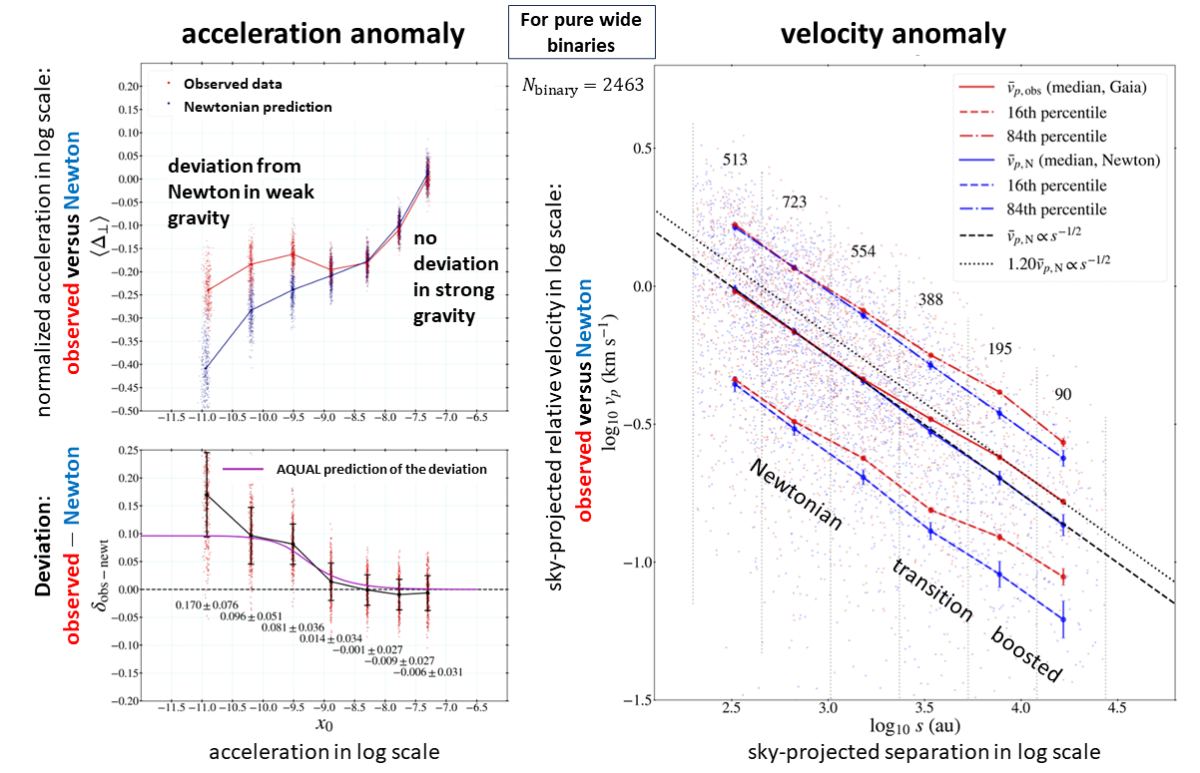The term dark matter was coined back in 1933 and since then, the hunt for it has been well and truly on. However, the concept of dark matter was to describe anomalies from observation for example the rotation of spiral galaxies and the data from gravitational lensing. An alternative soljution is that our model of gravity is simply wrong, enter MOND, Modified Newtonian Dynamics. A new paper just published explores wide binary stars and looks to see if it supports the MOND model.
Study the rotational velocity of spiral galaxies at different distances from the centre and you might be surprised. You would expect the rotational velocity to decrease with increasing distance from the centre, in reality we find that it remains the same with distance or even increases. Take into account our current model of gravity and it suggests that some unseen mass encircles the galaxy aka dark matter.

MOND as an alternative model was first published in 1983 by physicist Mordehai Milgrom. The model was proposed to explain stellar motion in galaxies without dark matter. Milgrom theorised that the gravitational force varied inverseley with the radius as opposed to the inverse square of the radius. The model explained the movements of stars in the outer region of galaxies without the need for dark matter.
Another observational discrepancy was reported in 2023 during a study of wide binaries. It seemed the orbital motions of binaries experience larger accelerations than Newtonian gravity predicts. Taking into account the effects of dark matter still does not resolve the equations. An opportunity therefore arose to explore wide binaries and the MOND model and, given that wide binaries are at the perfect distance for MOND effects to be detectable, it was an excellent test bed.
The sudy was carried out by Kyu-Hyun Chae, professor of physics and astronomy at Sejong University in South Korea. Using the European Space Agency’s Gaia telescope Chae gathered new data of 2,463 wide binaries, targeting those that were unlikely to be host to unseen companions. He then applied two algoritms to test the MOND model of gravity.

Both algoritms produced results that were consistent with MOND predictions for wide binaries. It should be noted that MOND only seems to be required for stars with component separations of about 2,000 astronomical units (1 astronomical unit equates to the average distance between the Sun and Earth.


Re “An alternative soljution [sic!]”:
MOND was an alternative model for spiral galaxies in the 1980s. But since then dark matter has been observed not only there and in its original galaxy cluster discovery but in many systems and with properties such as dark matter clumping which modified gravity theories simply can’t predict.
Lingering on in the margin of the tremendous success of general relativity such theories mostly heard the death knell came in 2017 with the multimessenger observation of a binary neutron star merger. Since gravity travel at the universal speed limit simple modified gravity theories – that predict other speeds – can’t work in a relativistic universe. [“Troubled Times for Alternatives to Einstein’s Theory of Gravity”, Quanta magazine, 2018.]
When that large nit has been picked remains the paper as an analysis. The paper that explicitly ruled out MOND in this last [!?] remaining corner of observational space for a classical instead of relativistic universe used ~20,000 well separated and vetted Gaia binaries (and was published by a group of astronomers). This paper uses a small ~ 2.000 subsample (and was published by a repeating MOND hypothesis proponent). The subsample observations show up as a cloud in a velocity-distance diagram and is used for line fitting of 6 [!] binned medians compared to a similar Monte Carlo model fit of Newtonian systems. 6 points do not make a statistically significant line fit. I am surprised that it was published at all, even more that it passed review.